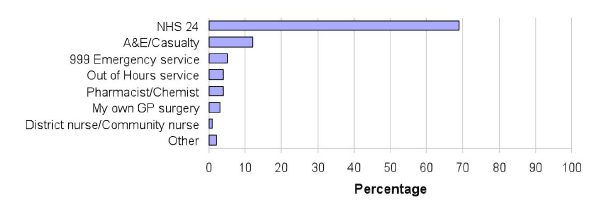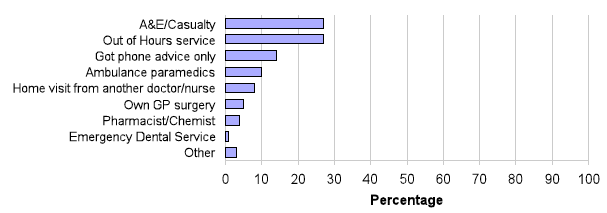Patient Experience survey of GP and local nhs services 2011/12 Volume 1: National Results
Scottish Patient Experience Survey of GP and Local NHS Services 2011/12. This is a postal survey which was sent to a random sample of patients who were registered with a GP in Scotland in October 2011. This report contains the national results, comparisons between NHS Boards and international comparisons.
This document is part of a collection
9 Out-of-hours healthcare
Summary
9.1 Patients were generally positive about their experiences of out-of-hours healthcare with 72 per cent rating their overall care they received as good or excellent. However this percentage is lower than the percentage of patients who rated the overall care provided by their GP practice as good or excellent (89 per cent). Of patients seeking help out of hours, 69 per cent spoke to NHS 24 first. More than half of patients seeking help out of hours were treated by an out-of-hours service or in A&E/ Casualty. More details on these and other findings are outlined below.
Introduction
9.2 From 1 April 2004, the Primary Medical Services (Scotland) Act 2004 placed a duty on NHS boards to provide 'primary medical services' for everyone living in the NHS board area. These are the services provided by GP practices to patients registered with them. NHS boards have a legal responsibility to ensure these services are provided at all times, including out-of-hours.
9.3 The out-of-hours period is: the period beginning at 6.30pm from Monday to Thursday and ending at 8.00am the following day; the period between 6.30pm on Friday and 8.00am the following Monday; and Christmas Day, New Year's Day and other public or local holidays.
9.4 Since 2004, GPs have had the option of continuing to provide a service during the out-of-hours period or to opt out of providing this service on condition that there is an acceptable alternative. Over recent years alternative arrangements for providing out-of-hours care have been established. In many cases this involves a number of agencies and healthcare professionals working together to provide an integrated service for patients.
9.5 Many patients contact the NHS in a way that is unplanned, for example if they become ill during the day or night, or at the weekend. It is crucial that the NHS responds in a way that meets the needs of the patient in a timely, person centred, safe and clinically appropriate way. Often the journey of care will involve more than one part of the healthcare system so it is important for systems and process to be joined up, and for patient information to be shared by the healthcare professionals involved in supporting patients.
Use of out-of-hours NHS services
9.6 The survey introduced questions on patients use and experience of out-of-hours services.
9.7 Of patients surveyed, 26 per cent had tried to get medical help, treatment or advice, for themselves or someone they were looking after, when their GP surgery was closed. Chart 10 and Chart 11 show which services patients first contacted to get help out of hours and who they ended up being seen by.
9.8 Of these patients who had sought medical help, treatment or advice when their GP surgery was closed:
- 69 per cent of patients who contacted a service outside their GP surgery opening hours initially contacted NHS 24
- 12 per cent initially contacted A&E/Casualty services
Chart 10: NHS service patients spoke to or got to first when they tried to get help out of hours

9.9 Over half of patients who contacted a service outside their GP surgery opening hours ended up being treated in out-of-hours or A&E/Casualty services (both 27 per cent). Another 14 per cent of patients received phone advice only.
Chart 11: Services patients ended up being treated by when they used out-of-hours services

9.10 The most common journeys through out-of-hours services (Table 8) were:
- 23 per cent of patients first contacted NHS 24 and were then seen by the out-of-hours service;
- 13 per cent of patients first contacted NHS 24 and were then treated in A&E/ Casualty;
- 13 per cent of patients first contacted NHS 24 and received phone advice only;
- 11 per cent of patients went to A&E / casualty and were treated there.
Table 8 Percentage of patients being treated by each service, by the service they spoke to first
| Service they ended up being treated by: | ||||||||||
|---|---|---|---|---|---|---|---|---|---|---|
| Service they spoke to first: | Out-of-hours service | A&E/ Casualty | Got phone advice only | Ambulance paramedics | Home visit from another doctor/ nurse | Own GP surgery | Pharmacist/ Chemist | Emergency Dental Service | Other | Total |
| NHS 24 | 23 | 13 | 13 | 6 | 7 | 3 | 1 | 1 | 2 | 69 |
| A&E/Casualty | * | 11 | * | * | * | * | * | * | * | 12 |
| 999 Emergency service | * | 1 | * | 3 | * | * | * | * | * | 5 |
| Pharmacist/ Chemist | 1 | * | * | * | * | * | 3 | * | * | 4 |
| Out-of-hours service | 2 | * | * | * | 1 | * | * | * | * | 4 |
| My own GP surgery | * | * | * | * | * | 2 | * | * | * | 3 |
| District nurse/ Community nurse | * | * | * | * | * | * | * | * | * | 1 |
| Other | * | * | * | * | * | * | * | * | 1 | 2 |
| Total | 27 | 27 | 14 | 10 | 8 | 5 | 4 | 1 | 3 | 100 |
* Less than 0.5%, but greater than 0%
Experience of out-of-hours healthcare
9.11 Patients were asked to rate their overall experience of the care provided by out-of-hours services. In total 72 per cent of patients rated the overall care they received out of hours as excellent or good, with 11 per cent rating it as poor or very poor. It is worth noting that fewer patients rated out-of-hours care positively than did for overall care provided by their GP practice, where 89 percent rated their care as good or excellent.
9.12 The survey also asked patients who had tried to get help out of hours how much they agreed or disagreed with the following five statements:
- The time I waited was reasonable
- I felt that the person had all the information needed to treat me
- I felt I was listened to
- Things were explained to me in a way I could understand
- I felt that I got the right treatment or advice
9.13 The statement that the most patients agreed with was that things were explained to them in a way they could understand (85 per cent). The statement that the fewest patients agreed with was that the time they waited was reasonable (76 per cent). The results are shown in the table below.
Table 9: Summary of results of out-of-hours questions
| Statement | Disagree or strongly disagree (%) | Neither agree nor disagree (%) | Agree or strongly agree (%) |
|---|---|---|---|
| Things were explained to me in a way I could understand | 6 | 9 | 85 |
| I felt I was listened to | 7 | 9 | 84 |
| I felt that I got the right treatment or advice | 10 | 10 | 80 |
| I felt that the person had all the information needed to treat me | 11 | 12 | 77 |
| The time I waited was reasonable | 15 | 9 | 76 |
Notes:
1. Statements sorted by percentage of patients strongly agreeing or agreeing.
2. Totals may not add due to rounding
Contact
Email: Gregor Boyd
There is a problem
Thanks for your feedback